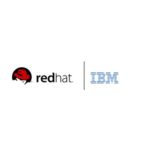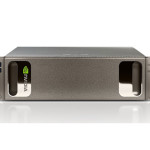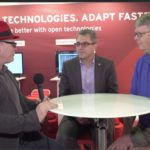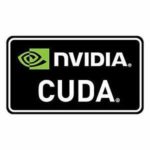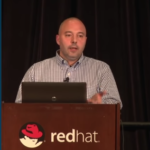Today IBM announced that the company plans to acquire all outstanding common shares of Red Hat for $190.00 per share in cash, representing a total enterprise value of approximately $34 billion. “One of the biggest enterprise technology companies on the planet has agreed to partner with us to scale and accelerate our efforts, bringing open source innovation to an even greater swath of the enterprise.”
Video: NVIDIA and Red Hat Simplify AI Development and Manageability
In this video, Tony Paikeday from NVIDIA describes how the DGX-1 for Red Hat Enterprise Linux is transforming enterprise computing with the power of Machine Learning. “Red Hat and NVIDIA have a solution with the certification of the NVIDIA DGX-1 for Red Hat Enterprise Linux. The combination enables enterprises to easily plug in and power up the AI supercomputer that has become the essential tool for AI innovators and researchers everywhere. And they can do so with a familiar operating system. In fact, 90 percent of Fortune 500 companies use Red Hat Enterprise Linux in their operations.”
Red Hat Powers NVIDIA DGX-1 for Ai Workloads
Today Red Hat announced it is collaborating with NVIDIA to bring a new wave of open innovation around emerging workloads like artificial intelligence, deep learning and data science to enterprise datacenters around the world. “Red Hat Enterprise Linux’s enablement of NVIDIA GPUs on our Sierra supercomputer provides commonality across our systems, greatly facilitating our users’ ability to exploit the world’s third fastest computer,” said Bronis Supinski, CTO of Livermore Computing.
How Red Hat Powers the #1 Summit Supercomputer
In this video from ISC 2018, Yan Fisher from Red Hat and Buddy Bland from ORNL discuss Summit, the world’s fastest supercomputer. Red Hat teamed with IBM, Mellanox, and NVIDIA to provide users with a new level of performance for HPC and AI workloads. ”
But the rapid innovation showcased by Summit must be consumable, and that’s where Red Hat Enterprise Linux comes in. Despite the scale, processing capability, and “intelligence” of Summit’s composition, end users interact with something they understand: Linux, in the form of the world’s leading enterprise Linux platform. Red Hat Enterprise Linux provides a common, stable basis that ties together all of this innovation.”
Red Hat’s Relentless Focus on Open Source Software Challenges Status Quo in Supercomputing
In this guest article, Red Hat Chief Technology Officer Chris Wright explores how his company’s focus on open source software is challenging the status quo in HPC and supercomputing. “In collaboration with our partners, Red Hat is enabling new hardware architectures, supporting various acceleration technologies and cache-coherent interconnects, and driving open innovation and standardization in high-performance computing.”
Supermicro Steps up to HPC & AI Workloads at ISC 2018
In this video from ISC 2018, Perry Hayes and Martin Galle from Supermicro describe the company’s latest innovations for HPC and AI workloads. “Supermicro delivers the industry’s fastest, most powerful selection of HPC solutions offering even higher density compute clusters to deliver maximum parallel computing performance for any science and engineering, simulation, modeling, or analytics applications,” said Charles Liang, president and CEO of Supermicro.
Supermicro, Red Hat, and Solarflare Set World Record STAC Performance
Today Supermicro announced a new world record for lowest latency on the well-known STAC-N1 benchmark. “This benchmark was performed on a pair of Supermicro SYS-1029UX-LL1-S16 servers, each with dual 8-core Intel Xeon Scalable 6144 (Gold) processors overclocked at 4.18GHz. The servers were also loaded with Red Hat’s Red Hat Enterprise Linux 7.5 operating system and Solarflare X2522 Adapters. Compared to all prior publicly released STAC-N1 results, the bare metal system demonstrated the lowest mean latency of 2.3 microseconds at both the base rate (100k messages per second) and the highest rate tested (1 million mps).”
NVIDIA Releases Cuda 9.2 for GPU Code Acceleration
Today NVIDIA released Cuda 9.2, which includes updates to libraries, a new library for accelerating custom linear-algebra algorithms, and lower kernel launch latency. “CUDA 9 is the most powerful software platform for GPU-accelerated applications. It has been built for Volta GPUs and includes faster GPU-accelerated libraries, a new programming model for flexible thread management, and improvements to the compiler and developer tools. With CUDA 9 you can speed up your applications while making them more scalable and robust.”
Red Hat’s AI Strategy
“The impact of AI will be visible in the software industry much sooner than the analog world, deeply affecting open source in general, as well as Red Hat, its ecosystem, and its userbase. This shift provides a huge opportunity for Red Hat to offer unique value to our customers. In this session, we’ll provide Red Hat’s general perspective on AI and how we are helping our customers benefit from AI.”
Celebrating 20 Years of the OpenMP API
“The first version of the OpenMP application programming interface (API) was published in October 1997. In the 20 years since then, the OpenMP API and the slightly older MPI have become the two stable programming models that high-performance parallel codes rely on. MPI handles the message passing aspects and allows code to scale out to significant numbers of nodes, while the OpenMP API allows programmers to write portable code to exploit the multiple cores and accelerators in modern machines.”

